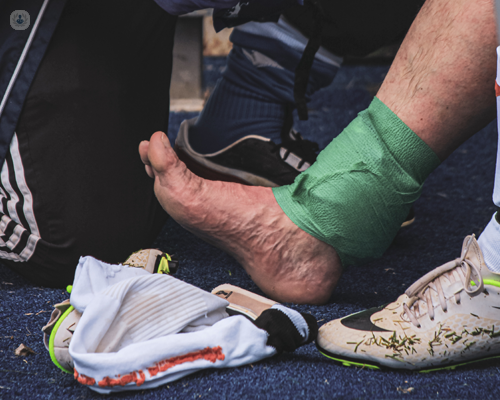Sports injuries: Effective management and recovery tips
Escrito por:Sports injuries are common among athletes of all levels, ranging from minor sprains to severe fractures or ligament tears. Whether you're a professional athlete or someone who enjoys recreational sports, leading private general practitioner (GP) with a special interest in sports medicine, Dr Siobhan Graham takes a look at understanding management and recovering from injuries, and how it’s essential to ensure a safe return to activity. Proper care can also reduce the risk of long-term damage or recurring issues.

What are the common types of sports injuries?
Some of the most frequent sports-related injuries include:
- Sprains and strains: These involve overstretching or tearing of ligaments (sprains) or muscles/tendons (strains). They often occur during sudden movements or falls.
- Fractures: Broken bones, which can happen due to impact or excessive force, are common in contact sports or those involving falls.
- Dislocations: Joints like the shoulder or knee can become dislocated during high-impact activities, leading to pain and limited movement.
- Tendon injuries: Tendonitis or tendon tears, such as in the Achilles tendon, occur due to overuse or sudden force.
- Concussions: Head injuries are prevalent in contact sports like football or rugby and require careful monitoring and rest.
How are sports injuries effectively managed?
Managing a sports injury properly is key to ensuring full recovery and preventing further damage. The following steps can help:
- Rest: Giving your body time to heal is crucial. Continuing to play or train while injured can worsen the injury and extend recovery time.
- Ice: Applying ice to the affected area helps reduce inflammation and numb pain. It should be done for 15-20 minutes every couple of hours in the initial 48 hours post-injury.
- Compression: Wrapping the injured area with a compression bandage can help control swelling.
- Elevation: Keeping the injured part elevated above heart level minimises swelling and promotes blood flow.
- Medical evaluation: For more severe injuries, such as fractures or dislocations, it's essential to seek medical attention immediately. A healthcare provider may recommend imaging, like X-rays or MRIs, to assess the damage fully.
Recovery tips
Recovering from a sports injury involves a combination of rest, rehabilitation, and preventive strategies:
- Physical therapy: A physiotherapist can help design a personalised rehabilitation plan to restore strength, flexibility, and range of motion in the injured area. This is particularly important for injuries involving the knees, shoulders, or other major joints.
- Gradual return to activity: It’s essential to avoid rushing back into sports too quickly. Start with light activities, and slowly build up the intensity. Your healthcare provider or physiotherapist will advise on when it’s safe to resume training fully.
- Strengthening exercises: Strengthening the muscles around the injured area helps protect against future injuries. Core and balance training can also enhance overall stability and reduce injury risk.
- Preventive techniques: Proper warm-up and cool-down routines, along with appropriate protective gear, can help minimise injury risks. Additionally, ensuring correct form and technique during sports can prevent strain on the body.
Understanding how to effectively manage and recover from sports injuries can help athletes avoid complications and return to their sport stronger and healthier.
Do you require expert sports medicine treatment? Arrange a consultation with Dr Graham via her Top Doctors profile.


